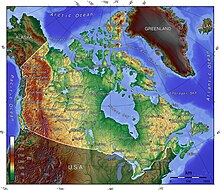

Volcanic activity is a major part of the geology of Canada and is characterized by many types of volcanic landform, including lava flows, volcanic plateaus, lava domes, cinder cones, stratovolcanoes, shield volcanoes, submarine volcanoes, calderas, diatremes, and maars, along with less common volcanic forms such as tuyas and subglacial mounds.
Though Canada's volcanic history dates back to the Precambrian eon, at least 3.11 billion years ago, when its part of the North American continent began to form,[1] volcanism continues to occur in Western and Northern Canada in modern times, where it forms part of an encircling chain of volcanoes and frequent earthquakes around the Pacific Ocean called the Pacific Ring of Fire.[2] Because volcanoes in Western and Northern Canada are in relatively remote and sparsely populated areas and their activity is less frequent than with other volcanoes around the Pacific Ocean, Canada is commonly thought to occupy a gap in the Ring of Fire between the volcanoes of the western United States to the south and the Aleutian volcanoes of Alaska to the north.[3] Even so, the mountainous landscapes of the Canadian provinces of Alberta, British Columbia, Yukon, and the Northwest Territories include more than 100 volcanoes that have been active during the past two million years and whose eruptions have claimed many lives.[3]
Volcanic activity is responsible for many of Canada's geological and geographical features and mineralization, including the nucleus of the North American continent, known as the Canadian Shield. Volcanism has led to the formation of hundreds of volcanic areas and extensive lava formations across Canada. The country's different volcano and lava types originate from different tectonic settings and types of volcanic eruptions, ranging from passive lava eruptions to violent explosive eruptions. Canada has a rich record of very large volumes of magmatic rock called large igneous provinces, represented by deep-level plumbing systems consisting of giant dike swarms, sill provinces and layered intrusions.[4] The most capable large igneous provinces in Canada are Archean greenstone belts estimated at 3.8 to 2.5 billion years old, containing a rare volcanic rock called komatiite.[4]
- ^ "Large Igneous Provinces in Canada Through Time and Their Metallogogenic Potential Appendix 2". Mineral Deposits of Canada. Geological Survey of Canada. September 24, 2008. Archived from the original on June 4, 2011. Retrieved January 21, 2009.
- ^ Cite error: The named reference
HEPOwas invoked but never defined (see the help page). - ^ a b Cite error: The named reference
SLVwas invoked but never defined (see the help page). - ^ a b Cite error: The named reference
GHEwas invoked but never defined (see the help page).